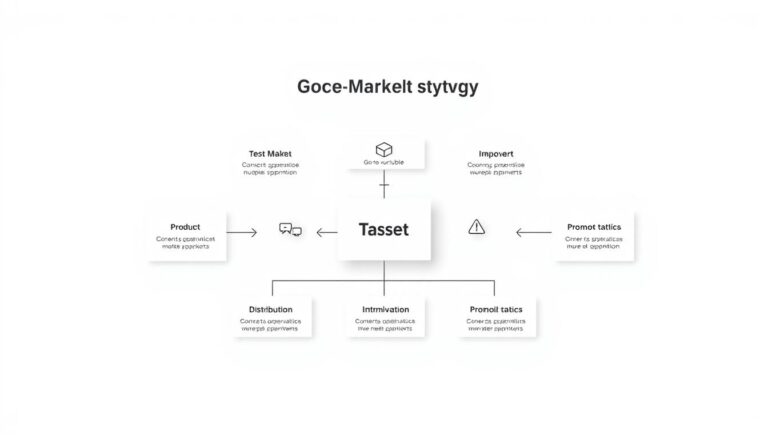In today’s fast-changing digital world, using GTM (Go-To-Market) strategy automation is crucial for companies that want to beat their rivals. Automating Google Tag Manager processes boosts efficiency and offers top-notch tag management. With customer demands growing, firms must use advanced technologies to ensure smooth customer experiences. GTM strategy automation is key for continuous success and standing out in the market.
Key Takeaways
- GTM strategy automation is crucial for business efficiency.
- Automating Google Tag Manager improves marketing effectiveness.
- Tag management solutions enhance data accuracy and speed.
- Utilizing these tools meets the rising customer expectations.
- Effective automation leads to significant business growth.
- Competitive advantage is achieved through streamlined processes.
Understanding GTM Strategy Automation Solutions
GTM strategy automation uses high-tech methods to upgrade marketing efforts. It uses gtm tools for better planning and carrying out tasks. This strategy is a move towards smoother operations that meet what customers want.
Definition of GTM Strategy Automation
GTM strategy automation combines gtm software and services to improve marketing plans. It uses data analysis and instant feedback to boost connecting with customers. This way, marketing can quickly adjust to any changes in the market.
Importance in Modern Business
Today, GTM automation is key for success in business. A whopping 73% of shoppers say they care a lot about how a brand treats them. Companies using gtm implementation services have a clear edge. They stay important and quick to fulfill what customers need.
Key Components of GTM Solutions
Great GTM solutions have several important parts:
- Data-driven decision-making capabilities.
- Seamless integration with account-based marketing strategies.
- Alignment of marketing teams to boost working together and efficiency.
Using advanced gtm tools helps businesses overcome new challenges successfully. Knowing these parts helps firms choose the best automation platforms for them. For more help, check out automation strategies for improving business.
Benefits of Automating Your GTM Strategy
Automation brings many wins for go-to-market (GTM) strategies. It helps companies work smarter and perform better. Let’s look at why automating your GTM plan is a smart move.
Increased Efficiency and Speed
Automation cuts down on manual tasks. This lets companies do things faster and more accurately. With best practices in place, teams have more time for big-picture thinking.
This shift boosts innovation and productivity.
Enhanced Data Analysis and Reporting
Automatic GTM tools give real-time updates. This helps companies make smart choices quickly. They can track how they’re doing and adjust as needed.
With advanced reporting, it’s easier to see where to get better.
Cost Savings Over Time
Although it costs to start, automation saves money later on. It makes better use of resources and cuts down on mistakes. Eventually, companies spend less and gain more financially.
How to Choose the Right GTM Automation Solution
Finding the right GTM automation solution needs a careful look at your specific needs and tech trends. It’s important to know what your business wants to achieve and how things are currently done. This way, you can choose gtm software that fits with your goals.
Assessing Your Business Needs
Start by listing what you need for your GTM strategy. Things to think about include:
- Scalability: The platform must be able to grow with your company.
- Functionality: Figure out the essential features you need.
- Compliance: See how the platform handles legal rules.
Evaluating Different Platforms
Then, compare different platforms. Look at how easy they are to use, their data analysis tools, and customer support. A side-by-side look could consider:
| Platform | User-Friendly | Analytics Capabilities | Support Services |
|---|---|---|---|
| Platform A | Yes | Advanced | 24/7 Support |
| Platform B | No | Basic | Business Hours Only |
| Platform C | Yes | Intermediate | Email Support |
Integration with Existing Systems
Make sure your chosen service works well with your current setup. It’s key for a smooth changeover and to keep your business running well. Check how the gtm automation platform works with what you already use.
Key Features to Look for in GTM Solutions
Choosing the right tag management solutions is about knowing what features will boost a business’s marketing. Essential elements include easy-to-use interfaces, strong analytics, and customization for specific needs. Focusing on these aspects makes sure companies get the most from gtm tools and improve their marketing strategies.
User-Friendly Interface
An easy-to-use interface in gtm tools is key for quick learning. It cuts down training time and boosts work output. A well-made interface makes it simple to find and use important features. This helps teams work together better, including marketing and sales.
Robust Analytics Capabilities
Strong analytics are vital for making informed choices. Companies need detailed reports on customer actions and how campaigns are doing. These insights help adjust tactics based on the latest data, raising investment returns. Advanced analytics can sharpen marketing efforts.
Customization Options
Being able to tweak tools for specific business needs is a huge plus. Customization lets companies fit gtm tools to their strategies. This means the tools can more precisely tackle unique challenges and be more effective. As seen in advanced techniques, specific solutions can greatly boost results in tight competition.

Case Studies: Successful GTM Automation Implementations
This section shows real examples to point out how GTM automation helps different industries. Each story shows the plans used, obstacles met, and the big benefits gained. It proves how valuable GTM implementations are.
Technology Sector Example
A big tech company used GTM services to make its user experience better with smart, data-driven methods. By using automated Google Tag Manager, they could track how users interacted on their site more effectively. This made site navigation easier, leading to a 25% jump in customer engagement. There was also a 15% boost in how often visitors turned into customers over six months.
Retail Sector Example
In retail, a well-known brand turned to GTM for better inventory control with automated tagging. This automation helped the company keep an accurate eye on how products and customers behaved. Because of this, they cut down on having too much stock by 30%. They also saw sales go up by 20% when items were in high demand, thanks to adjusting inventory with up-to-the-minute data.
Healthcare Sector Example
A healthcare group added GTM automation to better connect with and involve patients. They used GTM services to really understand what patients liked and what feedback they had. This made their communication better, leading to 40% happier patients. It also meant more patients came to their appointments.
Overcoming Challenges in GTM Automation
Starting with a GTM automation platform brings its own set of hurdles for businesses to overcome. Understanding these common problems helps in planning how to beat them.
Common Obstacles
Employees often resist change, sticking to the way things have always been done. Mixing old systems with a new GTM automation platform can cause data problems, affecting how information is shared. Also, not having enough resources, like money or staff, can slow down the use of best GTM practices.
Strategies for Effective Implementation
It’s important for marketing and sales to work together towards shared goals. Setting clear targets helps guide the setup process, making sure everyone knows their role. Training staff on how to use the GTM platform boosts performance and outcomes.
Continuous Improvement Practices
Companies must focus on continuous improvement, using data and feedback to refine GTM strategies. Checking performance regularly helps pinpoint where improvements are needed. This way, GTM practices stay up-to-date. A culture that values learning and adapting enhances GTM automation results significantly.

Future Trends in GTM Strategy Automation
The world of GTM strategy automation is always changing. This is because of new technology and creative ideas. Businesses are working hard to make their marketing better by using new tools. These tools help companies make their processes more efficient and improve how they talk to customers.
Evolving Technologies and Innovations
Cloud computing and real-time data analytics are changing the game for google tag manager automation. They let businesses understand their data better. This leads to smarter decisions that can make marketing much better. With these new technologies, teams can see changes coming. This helps them make their marketing strategies even better.
Impact of AI on GTM Solutions
Artificial intelligence is making GTM solutions much better. It brings in things like machine learning and predictive analytics. This makes it easier for businesses to connect with customers by guessing their future actions and preferences. AI is very important for GTM automation. It gives businesses the tools they need for marketing that really speaks to the individual and uses resources wisely.
Preparing for Tomorrow’s Market Dynamics
As the market changes, organizations need to be able to adapt and keep learning. The best strategy is to always update GTM tools and make sure teams know about the latest trends. By doing this, businesses can stay important in the market and find new chances for growth.
FAQ
What is GTM strategy automation?
GTM strategy automation uses technology to make marketing better and more efficient. It helps meet business goals.
Why is GTM strategy automation important for modern businesses?
It’s key for keeping up with rising customer expectations. It helps provide better services, meet demands, and stay ahead of competitors.
What are the key components of GTM solutions?
GTM solutions focus on making choices based on data, working with account-based marketing, and getting marketing teams to work together.
How does automation increase efficiency in GTM strategies?
Automation cuts down on manual tasks. This lets teams focus more on important work, boosting both productivity and quickness.
Can GTM automation lead to cost savings?
Yes, it might cost upfront, but in the long run, it makes better use of resources and cuts down on errors. This saves money over time.
What should businesses consider when choosing a GTM automation solution?
Companies need to look at their needs and current systems. They should think about things like easy growth, how simple it is to use, and strong analytics.
What features are essential in GTM solutions?
Key features include being easy to use, having strong tools for analyzing data, and offering options to customize for your business.
Can you provide examples of successful GTM automation implementations?
Yes, tech companies have made their services better with data, retail stores have managed stock more smartly, and healthcare has improved how they interact with patients.
What challenges do organizations face when adopting GTM automation?
The main issues are getting people to accept new methods, combining data properly, and having enough resources. These are important to solve for success.
How can organizations effectively implement GTM automation?
To do well, companies should encourage teamwork between marketing and sales, set clear goals, and train employees on the new tech.
What future trends should organizations anticipate in GTM strategy automation?
Look forward to new tech, especially AI, which will make marketing and customer service better. Being able to change and adapt is also crucial.



